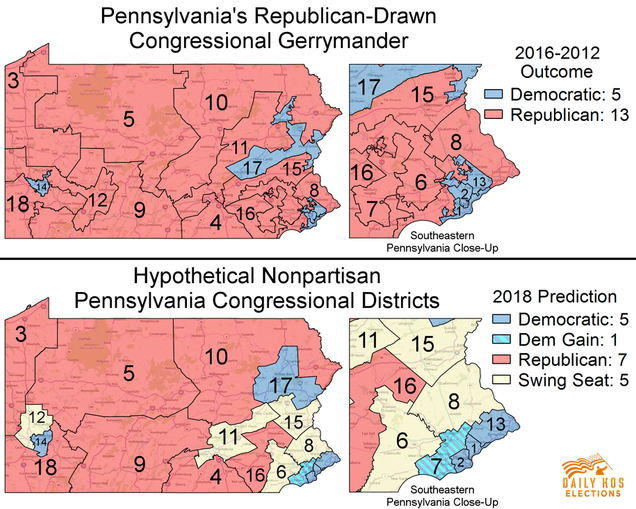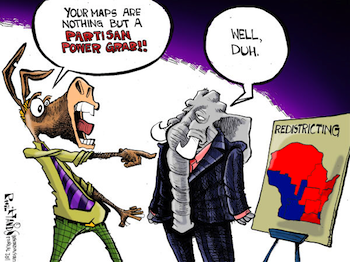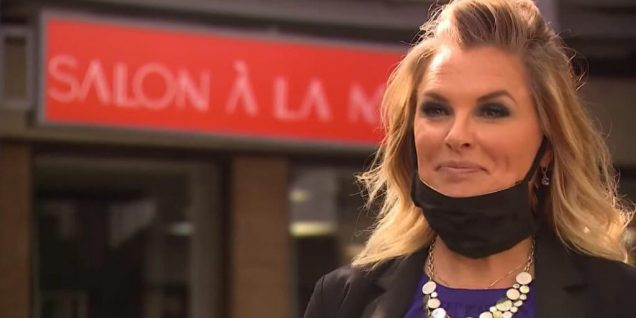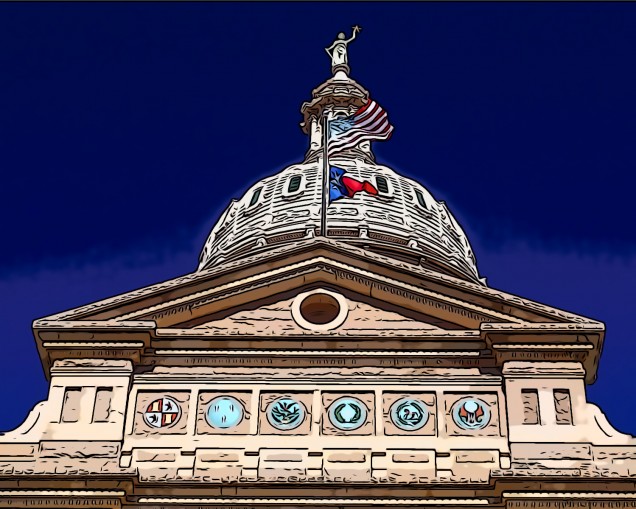Tagged: Texas
Checks & Balances in a Pandemic
Recently, Shelley Luther, a Dallas based hair salon owner was jailed for refusing to close down her salon. The owner of Salon à la Mode continued operating her business despite a temporary restraining order last week from Dallas County State District Judge Eric Moyé. She continued operating despite a county official’s cease-and-desist letter ordering her to close.
As Luther faced criminal and civil contempt-of-court charges, Judge Moyé told Luther to admit her actions were selfish and wrong and promise that she would follow the law. CBS DFW reported that Luther refused responding,
“I have to disagree with you, sir, when you say that I’m selfish, because feeding my kids is not selfish. I have hair stylists that are going hungry because they’d rather feed their kids. So, sir, if you think the law is more important than kids getting fed, then please go ahead with your decision, but I am not going to shut down the salon.”
This answer did not please Judge Moyé, who immediately sentenced Luther to seven days in jail. Luther was not given an opportunity to go home or even have a phone call, if it hadn’t had been for her boyfriend her adolescent daughter would not have understood why her mother didn’t come home that night.
During the COVID-19 Coronavirus Pandemic, officials have agreed that jail is a breeding ground for the virus. In order to best protect the people, officials have quickly worked to release many non-violent prisoners for the sake of their health. Dallas county specifically released 1,000 inmates to ease crowding in the hopes to slow the spread of COVID-19 at the Dallas County jail. At a time where officials are releasing prisoners, I find it inappropriate to make an example of Luther by throwing her in jail. Not only was this action a risk to her health, but a risk to her family and those exposed to her when she would be released a week later. Additionally, if Luther had been asymptomatic there was a risk that she herself could have brought the virus into the prison.
Furthermore, Dallas County District Attorney John Creuzot announced policy reforms plans to end mass incarceration in Dallas by decreasing the use of excessively high bail amounts, no longer prosecuting most first-time marijuana offenses and not prosecuting thefts of personal items under $750 that are stolen out of necessity. These policy reforms were established to decrease the number of incoming prisoners. Again, at a time where officials are fighting to decrease prison populations, Moyé’s actions neglected to consider the bigger picture. A better alternative would have been a fine for each day she was in operation, with the money allocated to benefiting the community.
Due to public outcry, Gov. Greg Abbott modified his executive orders to remove confinement as a consequence for violating them. He stated:
“Throwing Texans in jail who have had their businesses shut down through no fault of their own is nonsensical, and I will not allow it to happen,” Abbott said in a statement Thursday. “That is why I am modifying my executive orders to ensure confinement is not a punishment for violating an order.”
His change supersedes local orders and Luther was subsequently released. Luther was fined $7,000 for violating a temporary restraining order against reopening her business. However, Lt. Gov. Dan Patrick pledged to step up and pay the fine on her behalf.
The COVID-19 Coronavirus is an unprecedented time in our nation’s history, with legislators unsure how to best regulate protective measures. State legislators have gained an enormous power with COVID-19 Coronavirus. Without a doubt aggressive government intervention has occurred during this health crisis. Historically, pandemics have led to an expansion of the power of the state. Looking towards the future, legislators will have to work to strike a balance between protective regulations and domineering policies.
 Diana Alexandra Martinez anticipates graduating from Boston University School of Law in May 2021.
Diana Alexandra Martinez anticipates graduating from Boston University School of Law in May 2021.
Can Partisan Gerrymandering be Stopped?
Attention to partisan gerrymandering has heightened as the next wave of redistricting fast approaches and the Supreme Court’s 2017-2018 docket included two cases regarding the constitutionality of partisan gerrymander. Following the release of the 2020 census, states will set out to redraw their district maps. States redistrict at least every ten years. The 2010 redistricting results are described as the most extreme partisan gerrymandering in our country’s history. The 2010 maps have a heavy Republican partisan advantage, as evidenced by the 2012 election results with Republicans gaining a 234 to 201 seat advantage in the House of Representatives despite Democrats winning 1.5 million more votes than Republicans. The Republican partisan advantage has remained strong. The Brennan Center for Justice has predicted that in the 2018 midterm elections Democrats will need to win by a margin of nearly 11 points to gain a majority in the House of Representatives. Democrats, however, have not won by a margin this large since 1974. Following years of heavily gerrymandered districts, a supermajority of Americans have indicated support for the Supreme Court to bring an end to partisan gerrymandering, yet the Court failed to take action this year.
 Partisan gerrymandering is the carving of districts, into sometimes odd shapes, to benefit a political party’s electoral prospects. The term gerrymandering was coined after Elbridge Gerry, a Massachusetts’s governor, in order to describe an irregularly shaped district that looked like a salamander in an 1812 redistricting map he signed into law. As a result, partisan gerrymandering has been a defining feature of “American politics since the early days of the Republic.” While racial gerrymandering is unconstitutional, the constitutionality of partisan gerrymandering is an open question, as the Supreme Court has never struck down a map for partisan gerrymander.
Partisan gerrymandering is the carving of districts, into sometimes odd shapes, to benefit a political party’s electoral prospects. The term gerrymandering was coined after Elbridge Gerry, a Massachusetts’s governor, in order to describe an irregularly shaped district that looked like a salamander in an 1812 redistricting map he signed into law. As a result, partisan gerrymandering has been a defining feature of “American politics since the early days of the Republic.” While racial gerrymandering is unconstitutional, the constitutionality of partisan gerrymandering is an open question, as the Supreme Court has never struck down a map for partisan gerrymander.
Partisan gerrymandering seems to fly in the face of democracy. Voting is a fundamental right and electing who you want to represent you in office is a fundamental part of democracy. Legislatures that scheme, plan, and manipulate maps to benefit one party over another can undermine the purpose of democracy. Some of this scheming, planning, and manipulating is self-interested as legislatures try to protect incumbents and create safe districts, but can also serve the purpose of entrenching a political party’s majority until the next redistricting cycle. Both parties, Republicans and Democrats, have enjoyed the benefit of partisan gerrymandering when given the opportunity.
While the Supreme Court has indicated that some level of partisan gerrymandering may be unconstitutional, it has yet to explain when the constitutional line has been crossed. This term, the Supreme Court took up the question of partisan gerrymandering for the first time in more than a decade. The two cases before the Supreme Court were Gill v. Whitford and Benisek v. Lamone. The Supreme Court was asked to answer when partisan gerrymander crosses the constitutional line. Gill v. Whitford challenged a statewide map that has been deemed among one of the worst partisan gerrymandered maps in the country, with a significant Republican partisan advantage. Benisek v. Lamone challenged one congressional district in Maryland, with a significant Democratic partisan advantage. Some speculated that the Court took up both cases to deter an appearance that the Supreme Court prefers one party over the other. Another reason may be that the Wisconsin case was a challenge to a statewide map compared to the Maryland case challenging one congressional district.
The appellants attorney in Gill v. Whitford argued during oral arguments (see, page 62) that the Supreme Court is the only institution to put an end to partisan gerrymandering. The Court, however, sidestepped the entire issue by unanimously finding the Gill plaintiffs did not have standing, and that the challengers in Benisek had waited too long to seek an injunction blocking the district. The Supreme Court’s silence allows legislatures to continue to strategically gerrymander.
While the country waits on the Supreme Court to provide an answer on the constitutionality of partisan gerrymander, some states have attempted to take partisanship out of the process by using redistricting commissions, while others suggest that computers with algorithms should produce the maps. Yet, neither of these options individually seem to completely insulate redistricting from politics.
States have adopted redistricting commissions with the intention to remove partisanship from the redistricting process. However, this has often proved difficult to achieve, as finding non-partisan committee members is difficult and oftentimes the commission is appointed by partisan members, such as elected representatives and governors. States use different types of commissions and may only use a commission for redistricting the state map or congressional map. About 23 states use commissions for the state legislative maps and about 14 states use commissions for the congressional maps. The redistricting commissions can take the form of an advisory commission that makes suggestions to the legislature, a backup commission that draws the map if the legislature fails to redistrict, or as having the primary responsibility of drawing the map.
Even states that use independent redistricting commissions have had difficulties completely insulating the process from politics. For instance, in 2011, Arizona’s Independent Redistricting Commission chairwoman was removed by the Republican Governor and the Republican-controlled State Senate. The Governor accused the chairwoman of skewing the process for Democrats. The Arizona Supreme Court, however, reinstated the chairwoman and the United States Supreme Court upheld Arizona’s independent redistricting commission as a legitimate way to draw district maps. Although some states are moving toward redistricting commissions as a way to insulate the process from politics, these commissions are “only as independent as those who appoint it.”
While technological advances have been thought to help parties gerrymander more effectively, some suggest that similar technology could take politics out of the process with the proper algorithms. Brian Olson, a Massachusetts software engineer, wrote an algorithm to create “‘optimally compact’ equal-population congressional districts.” Olson prioritized the compactness requirement in an effort to reflect “actual neighborhoods” and because dramatically non-compact districts can be a “telltale sign of gerrymandering.” However, political scientists are skeptical about an algorithm prioritizing compactness, because it ignores other important factors, such as community of interest. Furthermore, someone needs to set the algorithm and there can be infinite map results. Thus, without very strict restrictions and guidelines, setting an algorithm and picking the map can still be an inherent gerrymander.
Removing politics completely from the redistricting process appears to be nearly impossible. Partisanship is deeply entrenched in the process, and dates back to even before the coined term “gerrymander.” Redistricting commissions do not always guarantee a partisan free redistricting effort, and while technology offers an alternative to human map drawing, humans are still making the final decision. Some combination of these efforts may help to lessen the amount of politics used in the redistricting process or lessen the appearance of partisanship, but are unlikely to completely end partisan gerrymandering all together.
 Mikayla Foster anticipates graduating from Boston University School of Law in May, 2019.
Mikayla Foster anticipates graduating from Boston University School of Law in May, 2019.
States’ Efforts for Veterans Should Be Models
Supreme Court justice Louis Brandeis once called America’s states “laboratories of democracy;” state legislatures can tinker with public policy and, in theory, see what works and doesn’t work. One area where these laboratories are in full swing is in the area of state-level veteran’s benefits.
Many states provide basic benefits, in addition to benefits provided at the federal level, for veterans who serve the nation honorably and meet eligibility criteria. Things like: free admission to parks, hunting and fishing licenses at low or no cost, reduced rates for education at state funded colleges and universities, tax reductions and rebates, and veteran’s preferences for hiring in state jobs, are relatively common. Some states experiment with veteran’s policy by pushing well beyond these common state programs. Texas for example, through the very generous Hazelwood Act, provides up to 150 hours of exemption from tuition for veterans at state colleges and universities, or, if the veteran doesn’t use the benefit, for their spouse or child. Quite a few states (including Massachusetts) fund veteran’s nursing homes and are working to tackle veteran’s homelessness.
All of these programs are impressive and necessary and, they couldn’t be more important. Current veteran suicide rates are staggeringly high. More than seven thousand veterans took their lives in 2014. Of those veterans 70% were not enrolled in the federal VA system. That crisis, coupled with high veteran homelessness rates, poses significant risks to veterans living on the border of, or in, poverty. States address these challenges among their veteran populations in a variety of ways, but it is the way that Massachusetts offers commonwealth veterans in need assistance that show its progressive roots. Roots that stretch back to the Civil War.
During the Civil War, Massachusetts passed Mass. General Law Chapter 115 (Chapter 115). The statute has grown since then, but it has always provided a veteran’s agent in every Commonwealth municipality and assistance with veteran burials and grave services. Today, Chapter 115 benefits still provide a veteran’s agent (now referred to as a veterans service officer or VSO) and cemetery services, but the statute also provides a comprehensive benefit that truly seeks to serve those who have served.
This benefit is probably one of the most effective income-assistance benefits in the nation. It is funded through a city/state partnership where the city’s employee, the Veteran Service Officer (certified and trained by the state Department of Veteran’s Services), uses the regulations promulgated by the state Department of Veteran’s Services (108 Code of Massachusetts Regulation) to makes a determination about the eligibility of the veteran. Initially, if a veteran is eligible for Chapter 115, the veteran’s benefit is paid from the city’s budget. This process makes the Veteran Service Officer accountable to their respective Mayors, City Mangers, and City Councils.
In addition to being accountable to the municipal leadership, when a VSO approves Chapter 115 benefits auditors at the state Department of Veteran Services also reviews the veteran’s file to ensure that eligibility criteria are met and statutory guidelines and obligations are followed. If a VSO denies chapter 115 benefits, or removes a veteran from the program for failure to comply with job searches or income reporting mandates, the veteran can appeal that decision to the state Department of Veteran’s Services (and to higher administrative courts if necessary).
Throughout the veteran’s participation in the Chapter 115 program the Veteran Service Officer has statutory obligations to help the veteran file any and all VA claims and applications for healthcare and other social safety net benefits and to ensure that veterans that are able to work are actively seeking employment and reporting their income to the VSO. Commonwealth VSOs become, throughout this process, the veteran’s advocate, mentor, and coach. Finally, at the end of the fiscal year, 75% of the Chapter 115 benefits that the city pays out are reimbursed by the state Department of Veteran’s Services.
Are Chapter 115 benefits a perfect solution to all the challenges that commonwealth veterans face? Of course not. No government program, non-profit, charity, or business can address all of the complex issues that American veterans deal with. The challenges in transitioning from service in our all-volunteer military to civilian life are serious, but they are surmountable. Examples like the Hazelwood Act and Chapter 115 benefits are just two examples of how to create a net of support for veterans. Other states should look to Texas and Massachusetts to create similar programs, while continuing to experiment.
 Kenneth Meador was an Army combat medic who graduated from the University of Oklahoma and Boston University School of Law (2018). He plans to focus his legal career on helping our nation's veterans.
Kenneth Meador was an Army combat medic who graduated from the University of Oklahoma and Boston University School of Law (2018). He plans to focus his legal career on helping our nation's veterans.





